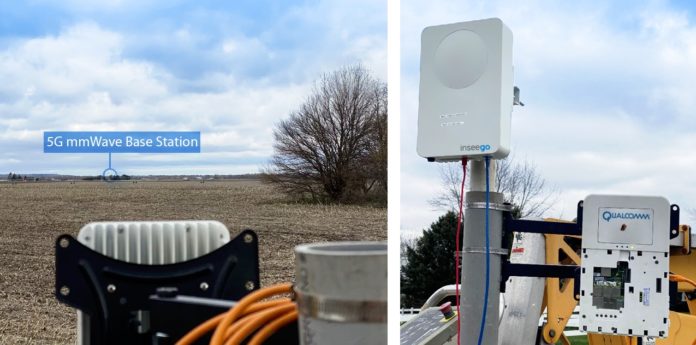US Cellular continues to push the limits of 5G millimeter wave, announcing this week that it was able to demonstrate sustained average downlink speeds of about 1 Gbps and peak speeds of more than 2 Gbps in its live network at a distance of 7 kilometers, which it says is the longest 5G mmWave Fixed Wireless Access connection in the U.S.
The carrier worked with Qualcomm Technologies, Ericsson and Inseego on the field test, which took place in Janesville, Wisconsin and applied extended-range functionality to Ericsson’s commercial hardware Antenna Integrated Radio (AIR) 5322 advanced antenna system, along with an Inseego Wavemake 5G outdoor CPE FW2010, which uses Qualcomm’s 5G FWA Platform (Gen 1) that includes the Snapdragon X55 5G modem-RF system and a Qualcomm QTM527 mmWave antenna module.
In addition to the 7 km line-of-sight link, US Cellular said that at a distance of 1.75 km with no line of sight, the partners were able to get sustained average downlink speeds of about 730 Mbps and sustain average uplink speeds of about 38 Mbps.
“We believe that every household and business deserve access to reliable Internet access no matter where they are located, and the results we achieved in this latest mmWave test further confirm that wireless technology is key to providing high-speed broadband service in both urban and rural areas,” said Mike Irizarry, EVP and CTO of US Cellular. “By collaborating with companies like Ericsson, Qualcomm Technologies and Inseego, we will continue to drive innovation with extended-range technology to ensure that wireless customers across rural America have an exceptional wireless experience designed for their communities.”
“We’re delivering exceptionally high throughput at a very long distance with millimeter wave technology,” said Ashish Sharma, president of IoT and mobile solutions at Inseego. “In addition to bringing 5G to enterprise and home broadband customers almost anywhere, we see a great market with the FW2010 for infrastructure backhaul applications. This is truly a game-changer for the FWA market.”
Last September, US Cellular achieved an extended-range data call — also in the Janesville location — over a more than 5 km distance with speeds exceeding 100 Mbps, working with Ericsson and Qualcomm Technologies. Irizarry called that test “a key strategic milestone in our 5G evolution.”
In related news, US Cellular also reported its results this week. The carrier made gains in operating and service revenues, the company reported, and it saw decreased customer losses, though its net income was down somewhat from the same period last year.
The carrier posted net losses of 6,000 lines, which included a loss of 9,000 feature phones and 3,000 connected devices, but a gain of 6,000 smartphones. Comparatively, the company had lost a net loss of 26,000 lines in the year-ago quarter. Its churn rate improved from 1.21% in the first quarter of 2020 to 1.12% in the first quarter of 2021. US Cellular ended the quarter with a customer base of 4.406 million.
Operating revenues were up to just over a billion dollars for the quarter, compared to $963 million in the year-ago period. Service revenues reached $771 million, up from $762 million at the same time last year. Net income dropped from $71 million during the same period in 2021, to $60 million.
Laurent Therivel, US Cellular president and CEO, called the results a “strong start to 2021,” adding that the company has attractive promotions in place and has adopted a regional model to execute more market-specific efforts.
“One of our top priorities and key competitive differentiators is to connect customers with the highest-quality network, including in underserved areas. Our 5G and network modernization programs are on track and we now offer 5G in portions of substantially all of our markets,” Therivel said. “We have also begun deploying our mmWave spectrum in order to offer fixed wireless access in three test markets, which will provide us with valuable learnings as we look to roll out this high-speed product to additional markets in our footprint. Our purchases of mid-band spectrum in the recent auctions will further enable our 5G capabilities well into the future.”
In the C Band auction, US Cellular purchased 254 licenses for a total cost of $1.46 billion, which it has said cover 94% of its subscribers.

